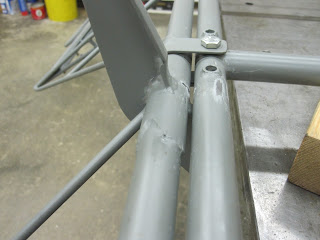
When the elevator travel stops are installed the tail feathers will be ready to cover. The horizontal stab/elevator assembly was clamped to the welding table and leveled. A digital level was used to measure the angle of deflection.

I decided that the travel stops could be simple shims of the appropriate thickness to fill the gap between the elevator horn and the main spar tube of the horizontal stab when the elevator was at it's travel limit. The shim thickness was determined by inserting feeler gauges when the elevator was deflected the prescribed 24 degrees up and down.

The down stop needed a .160" shim and the up stop needed a shim .068". A collar was lathe turned to have a 3/4" ID with a .160" wall thickness. A sanding belt was used to reduce a portion of the wall thickness down to .068" thickness at the point of contact with the elevator horn. Half was cut away leaving a one piece shim to accomplish the up and down stop function.

This shows the shim in position from the top side.

This shows the shim from the bottom side with the elevator horn against the stop at 24 degrees deflection. .

After welding.

Close enough!
 When the elevator travel stops are installed the tail feathers will be ready to cover. The horizontal stab/elevator assembly was clamped to the welding table and leveled. A digital level was used to measure the angle of deflection.
When the elevator travel stops are installed the tail feathers will be ready to cover. The horizontal stab/elevator assembly was clamped to the welding table and leveled. A digital level was used to measure the angle of deflection. I decided that the travel stops could be simple shims of the appropriate thickness to fill the gap between the elevator horn and the main spar tube of the horizontal stab when the elevator was at it's travel limit. The shim thickness was determined by inserting feeler gauges when the elevator was deflected the prescribed 24 degrees up and down.
I decided that the travel stops could be simple shims of the appropriate thickness to fill the gap between the elevator horn and the main spar tube of the horizontal stab when the elevator was at it's travel limit. The shim thickness was determined by inserting feeler gauges when the elevator was deflected the prescribed 24 degrees up and down.  The down stop needed a .160" shim and the up stop needed a shim .068". A collar was lathe turned to have a 3/4" ID with a .160" wall thickness. A sanding belt was used to reduce a portion of the wall thickness down to .068" thickness at the point of contact with the elevator horn. Half was cut away leaving a one piece shim to accomplish the up and down stop function.
The down stop needed a .160" shim and the up stop needed a shim .068". A collar was lathe turned to have a 3/4" ID with a .160" wall thickness. A sanding belt was used to reduce a portion of the wall thickness down to .068" thickness at the point of contact with the elevator horn. Half was cut away leaving a one piece shim to accomplish the up and down stop function. This shows the shim in position from the top side.
This shows the shim in position from the top side. This shows the shim from the bottom side with the elevator horn against the stop at 24 degrees deflection. .
This shows the shim from the bottom side with the elevator horn against the stop at 24 degrees deflection. . After welding.
After welding. Close enough!
Close enough!

No comments:
Post a Comment